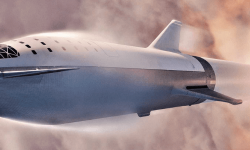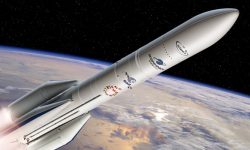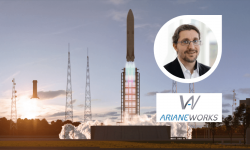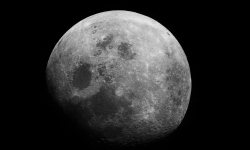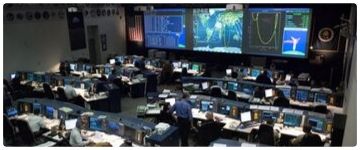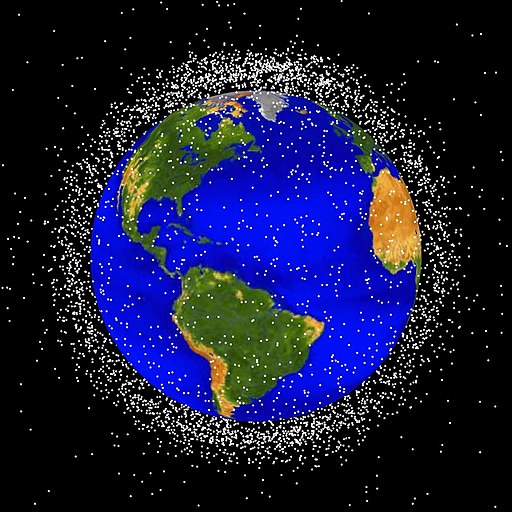
Space debris, mega satellite constellations : emergency in the Earth orbit
– News of April 18, 2019
Tens of thousands of space debris in Earth orbit
Humanity has been able to put satellites in orbit for more than 60 years. Its space activities have been the source of invaluable scientific discoveries and great moments in history. We had a high launch rate in the 1960s and 1970s, then a slowdown with the end of the Cold War. For a few years now, the number of orbital launches has been rising again. By 2018, more than 100 rockets have been launched towards the Earth orbit or beyond. We had not seen this level of activity for almost thirty years. This good health of the space sector obviously thrills space enthusiasts, but this should not obscure the impact of space activity on the environment.
More than 60 years of orbital flights have left tens of thousands of artificial debris in the near vicinity of the Earth. Satellites arrived at the end of their lives, rocket stages and fragments of all kinds wander at all altitudes and at incredible speeds. At 28,000 km/h, a simple bolt is a lethal weapon. For the moment, the impact of these space debris has been minimal, even though there have been some accidents. In 1996, a French military satellite became the first official casualty of a collision with space debris. A third stage of an Ariane 1 rocket launched ten years earlier is responsible. Since then, half a dozen similar accidents have been reported. The most serious of these occurred in 2009. A satellite of the Iridium constellation was destroyed in a collision with a disused Soviet satellite. Both satellites were destroyed and joined the many other micro-space debris.
The origins of space debris are numerous
The anti-satellite missiles tests carried out by the United States, China or lately India have also generated large quantities of space micro-debris. For the moment, the Earth’s orbit remains an immense space and the largest space debris are tracked by radar. However, more and more frequently, satellites need to burn their precious fuel to get away from a collision course. For example, ESA’s CLIOSAT satellite was on a collision course last summer. It is more and more frequent. Every day, the US Army issues around 20 warnings about the risk of collision in Earth orbit. In most cases, this is just a call for vigilance, but looking ahead, the outlook is not good.
Not only are the launches more and more numerous, but each rocket carries more and more satellites. This is one of the perverse effects of the Smallsats revolution. All over the world, start-ups are raising funds to orbit constellations of tens, hundreds or even thousands of these small satellites. OneWeb, SpaceX, Amazon and many other companies could launch tens of thousands of satellites over the next decade. These objects will have to find their place in an already well charged environment.
Emergency is to deal with space debris in low orbit
Nowadays, the low orbit is the most congested. About 16,000 artificial objects are currently in low orbit, that is to say less than 2000 km altitude. The geostationary orbit is also already crowded with nearly 3000 human objects. Between these two altitudes, 1500 satellites and other space debris move on different paths. The main problem is that the trajectories of all these objects are not known precisely. The orbit of a space debris can thus be different according to the origin of the data, Russian or American.
It was complicated when only states had access to space, but putting a satellite in orbit is now within the reach of many universities and startups, and some of them are not very careful about regulation. At the end of 2017, a company launched four micro-satellites without the authorization of any government. If everyone starts doing the same thing, Earth’s orbit may turn into a real Wild West.
The management of space debris and satellite constellations must be global
A big part of the work that avoids collisions is the cooperation between the various organizations which put objects in orbit. Since the early 1990s, many space agencies have joined the Inter-Agency Space Debris Coordination Committee (IADC), which is creating a series of guidelines to try to manage the problem. This committee therefore recommends depressurizing all the containers of a satellite that has reached the end of its life, which should make it possible to avoid accidental explosions, a risk that should not be taken lightly. In recent days, images of an Intelsat satellite undergoing uncontrolled explosions have been published on the internet. A fuel leak would be the problem. The committee also recommends lowering their orbit sufficiently to burn in the atmosphere in less than 25 years. These are unfortunately only guidelines and no sanction are provided against an organization which does not respect it. So far, only half of the missions have complied with this framework.
Space debris is an excellent example of a problem that would benefit from a global solution. In worst case scenarios, it is possible for humanity to completely lose the use of Earth’s orbit. This is Kessler syndrome, in which the increase in the number of objects in orbit will increase the number of collisions and each collision will create a large number of new space debris, which in turn increase the chances of collision. There is therefore a risk of a chain reaction that could make some orbits completely impassable. Some services such as GPS or satellite telecommunications may disappear.
All orbits are not managed in the same way. The lowest orbits are regularly cleaned by the residual layers of the atmosphere. But some experts believe that the layer between 900 km and 1200 km altitude will soon be saturated. This altitude is targeted by the satellites of the OneWeb constellation and by more than 4,000 satellites in the Starlink constellation. Fortunately, OneWeb and Starlink should face even more stringent constraints than those formulated by the Inter-Agency Space Debris Coordination Committee (IADC). OneWeb has announced that its satellites will now be killed only five years after their end of life. Some of their fuel will be reserved for this task. The satellites of the Starlink constellation should also be capable of that.
There are solutions to reduce the number of space debris
However, this may not be enough. It only takes one accident to add to thousands of space micro-debris that can not be tracked by radar. This is why some people are already preparing strategies for active cleaning of the orbit. This task seems hard because de-orbiting tens of thousands of dangerous space debris would require the investment of enormous resources. However, we can act cleverly by focusing on the largest space debris because they are the most likely to cause a chain reaction if it explodes. For the moment, only tests are carried out.
The Remove Debris satellite was put into orbit a year ago and has shown that it can capture small targets with a net and a harpoon. Once the collection is complete, it will increase its atmospheric drag with a large sail to accelerate its return to the atmosphere. The European Space Agency is also particularly active in this area. Through its Clean Technologies initiative, ESA is considering a mission to deorbit an old satellite with a robotic net or arm, which would be a world first. This test could take place as early as 2023. Other organizations are thinking about spacecrafts specialized in the repair and refueling of satellites. Increasing their lifespan means reducing the need for new launches. China has proposed using a high-power laser in orbit to deflect some space debris and accelerate their re-entry into the atmosphere. These solutions are slow and expensive, but at least they exist.
The spatial activity of Humanity has also consequences on the Earth’s atmosphere
The space industry is also responsible for some pollution of the Earth’s atmosphere. Although some of the engines used release only water vapor, other engines release very toxic combustion wastes. Russia’s Proton launchers, for example, are responsible for this kind of atmospheric pollution. The effects of launches on the atmosphere are still poorly known. For a hundred launches a year, the impact is probably very small. However, it will be necessary to deal with it if the rate of fire is to accelerate. For example, suborbital mass tourism could have a significant impact on the atmosphere.
To this must be added the atmospheric reentries of space debris. Space debris do not magically disappear, they burn in the atmosphere and the consequences of these combustions are found directly in the atmosphere. The space industry uses all kinds of exotic materials, some of which are radioactive. There have been incidents of RTGs and even nuclear reactors entering the atmosphere, triggering long and costly decontamination operations.
2019 could be a pivotal year for the management of artificial objects in space
Like all human activities, the space industry has an impact on the environment. In 60 years, Humanity has put into orbit a pretty incredible number of artificial objects. The vast majority of these objects are no longer useful and are a risk. The year 2019 will be the beginning of the era of mega satellite constellations that will grow this problem. Let’s hope that an intelligent management of the end of life of the satellites will be put in place. We must be very vigilant to avoid collisions and a possible Kessler syndrome. It will also be interesting to quantify the impact of rocket launch activities on the greenhouse effect or the ozone layer. Human adventures to the Moon or the planet Mars must not take place at the expense of the blue planet.

Space debris cleaning companies prove themselves
– News of November 6, 2018 –
RemoveDebris is an European initiative to test the deorbiting techniques of space debris. The satellite’s experiments will continue in 2019. The first results are conclusive. In September, RemoveDebris managed to capture a satellite with a net. This demonstration could pave the way for a real deorbitation service for space debris. But tackling debris one by one may be extremely expensive. It seems that there is really no other alternative. A DARPA study says that the cleaning of Earth’s orbit will inevitably become essential to keep operational risks at an acceptable level, and since 2011 the outlook is not good.
A few days ago, Elon Musk said he is trying to speed up the Starlink constellation, which should be made up of hundreds or thousands of small satellites. SpaceX began its deployment, and by the middle of next year the constellation could climb up to 12,000 satellites. Other companies have ambitious plans too.
It was reported on October 31 that the Japanese company Astroscale has received $ 50 million in funding. Astroscale works on the management of space debris. The company wants to develop satellites capable of orbital rendezvous maneuvers. They could then fetch satellites at the end of their life and then take them to the atmosphere. Astroscale thinks that with the launch of satellite constellations, a big market is opening up. Starlink, OneWeb and other satellite constellations projects are going to have such an impact on Earth’s orbit that the law should evolve to reflect that. Public authorities and private operators will necessarily have to take into account this problem, even if the cost is high.
Astroscale therefore hopes to be able to offer a viable solution, technologically and economically. This $ 50 million funding is also a sign of a healthy private Japanese space sector. Last December, a lunar exploration company received $ 90 million in funding, and in March 2018 the Japanese government announced nearly $ 1 billion over five years to support its private space sector. The number of space debris is increasing, despite the increased awareness of businesses and governments. Let’s hope that an incident will not have to happen before strong decisions are made.
The RemoveDebris experiment tackles space debris with a net and a harpoon
– News of June 26, 2018 –
In 2017, 335 SmallSats were launched with weights ranging from a few tens of grams to a few hundred pounds. That’s six times more than in 2012 and the trend should continue to accelerate. Businesses, universities, governments and armies seem to love SmallSats. All these launches are a sign of a thriving space industry. But putting a payload into orbit requires a certain technical mastery and generates responsibilities. With the proliferation of satellite operators, how can we ensure that everyone is serious ?
Last January, the FCC, the regulator of satellite telecommunications in the United States of America, revealed that four SmallSats had been launched without its approval. The FCC found these satellites dangerous because they were too small to be easily tracked by radar. It’s already hard to avoid collisions when everyone follows the rules. In addition to this, SmallSats often remain in orbit years after the end of their operational life. The congestion of the Earth’s orbit is therefore likely to accelerate and the problem of space debris is becoming more and more difficult to ignore.
The RemoveDebris experiment has just been launched from the International Space Station. This is again a SmallSat that was built by the University of Surrey in the UK with the participation of Airbus. RemoveDebris has a mass of a hundred kilos. This is the largest satellite launched from the ISS. It embeds three experiments that will test three different methods to deorbit space debris at the end of life. For the purposes of its demonstrations, the small satellite embeds its own targets that will be released before being deorbited. It is forbidden to touch the satellites of another, even if they are no longer operational.
The satellite will spend the next few months being tested, then in September or October the first experiment should start. RemoveDebris will let a small CubeSat go up to a distance of a few meters, then throw a net to get it back. In a few millennia, the methods of capture have not changed much. In February 2019, RemoveDebris will test a harpoon. RemoveDebris will let a CubeSat go before bringing it back with a harpoon. Captured SmallSats is a good thing but then you have to treat them. This is where the third experiment comes in. After releasing and capturing both targets, in March 2019 RemoveDebris will deploy a sail that will significantly increase its drag. The very small traces of gas in low Earth orbit will cause the combustion of RemoveDebris in the Earth’s atmosphere. During these few months in orbit, the experimental satellite will also test a navigation technology. The goal is to be able to follow small, distant targets.
All the experiences will be filmed to ensure their smooth running. If the experiment is a success, we can perhaps imagine satellite cleaners that harpoon a few dozen space debris before deorbit itself with a sail. This may be slow and expensive, but it’s still better than having a low orbit that is impractical. The technique of sailing would work only for low altitude orbits.
The Chinese space station Tiangong-1 is destroyed
– News of April 3, 2018 –
The Chinese space station Tiangong-1 burned over the Pacific Ocean on April 1. This is not the first time a space station has made a destructive atmospheric reentry. In 2001, MIR was also damaged in the Pacific Ocean. The South Pacific Ocean may become a space station cemetery. The International Space Station (ISS) will also likely crash there. For this, we must successfully control the atmospheric reentry of these space stations, which is not easy.
Russians have experience. In addition to MIR, they managed to control the atmospheric reentry of space stations Salyut 4, 5, 6 and 7. On the side of the United States, it is a little less glorious. The atmospheric reentry of the Skylab, voluntarily uncontrolled, ended with debris hitting the populated areas of western Australia, fortunately without casualties.Tiangon-1 had been launched in 2011. It was the first chinese space station. Tiangong-2 was launched in 2016, and a new space station is expected to begin assembly this year. It will be much more massive with three pressurized modules. The chances of being hit by a debris are thankfully very low, but we remember that less than three months ago a floor of a rocket crashed in a village in China.
The multiplication of launches inevitably generates more debris and more atmospheric re-entry. We could already say that they have become daily or almost. Fortunately, most of this debris is not massive enough to reach the ground. In the coming days, a dual launch system of an Ariane 5 rocket launched in May 2007 should also make a destructive comeback. The piece is only 440 kg. We will be entitled to a little bigger with the destructive fall of the RXTE (Rossi X-ray Timing Explorer) satellite of 2.7 tons, launched in 1995 by NASA.
Among the other factors of multiplication of the atmospheric re-entries, there are also the methods of cleaning the low orbit, for example the experiment RemoveDebris which was launched yesterday with a Falcon 9 rocket. It will try to capture a CubeSat with another satellite, then the whole will drop to the upper atmosphere. Perhaps in a few decades, the Earth’s nights will be illuminated by artificial shooting stars, witnesses of an intense activity of man in space.
Lasers could remove space debris from Earth’s orbit
– News of January 23, 2018 –
With all Smallsats launches, we wonder if Earth’s orbit will not become a landfill. The multiplication of objects in orbit multiplies the risk of collision. In orbit, there are machines worth billions of dollars and even human lives. Space agencies and private companies are trying to find solutions to this problem. Even China seems more and more involved to solve this problem. And yet, it was far from obvious because the debris cloud currently in orbit was largely created during a Chinese anti-satellite missile test in 2007. This cloud of debris even caused significant damage to a Russian satellite in 2013. China is putting into orbit more and more satellites and now has to worry about its debris, and other space agencies too. For the moment, the actions are limited to the desorbitation of satellites and space stations at the end of their life. The Tiangong-1 space station should soon return to Earth.
A university linked to the Chinese Air Force proposes to use lasers to clean the orbit a little. The goal is not to use these lasers to disintegrate debris, which would be counterproductive because you would get smaller debris. The approach of the university team is a little more subtle. They think that by targeting a small part of a space debris, it is possible to give it an acceleration and thus to modify its trajectory and thus be able to deorbit it.
To achieve optimal results, the laser should be placed in a space station. But the United States of America is not in favor of the presence of a Chinese laser in orbit. It is difficult to judge if this approach starts from a real good will or if it is just an excuse to install lasers in space. After all, lasers could also work on targets that are not yet space debris. In a way, this could be perceived as a violation of the space treaty that prohibits the deployment of weapons of mass destruction in outer space, and China has been one of its signatories since the 1980s.
Brane Craft, a concept for cleaning space debris from Earth’s orbit
– News of September 26, 2017 –
Space debris is a growing danger. They increase the risk of collision with satellites and other objects that gravitate around the Earth. NASA is working on this issue by developing with Aerospace Corporation the Brane Craft, a small spacecraft one meter by one meter, and a thickness less than a human hair. It works by wrapping itself around its target to capture it. This is still a concept of studies for NASA, but the solution is particularly ingenious and economical if the technical challenges that accompany it can be solved.
NASA has just renewed a two-year grant to its partner company to continue research on the micro-spacecraft. To de-orbit its target, a Brane Craft will use electric propulsion. Its surface is covered with photovoltaic cells and its fuel is stored in the 10 micrometers separating the two sheets of capton that make up the spacecraft. The set weighs only 80 grams but would be able to de-orbit a 2 kg space debris in low orbit. Propulsion would be provided by an electro-spray motor, a form of electrostatic propulsion that will also be miniaturized to fit in the thickness of a hair. The set appears very effective with a specific pulse of 4000 seconds in the sunlight conditions of the Earth’s orbit. The interest is to be able to launch several thousands of these Brane Craft with a single rocket, thus making it possible to clean the low orbit, quickly and with a relatively low cost.
But there are still many challenges before they can be sent to capture space debris. Ultra-miniaturization comes at a cost and Aerospace Corporation estimates that a Brane Craft would cost $ 5000 for just 80 grams. The electronics and materials used to make the Brane Craft must be able to survive at least ten days in the extreme conditions of space. But if Aerospace Corporation manages to develop the Brane Craft, then the company will have opportunities that go far beyond simply cleaning up space debris in Earth’s orbit. Due to its very low weight and large surface area of solar panels, the spacecraft would end up with an excessive power-to-weight ratio. Indeed, it would actually be able to go into orbit around Neptune with only 27 grams of fuel contained in the spacecraft. But the efforts of miniaturization and research on the materials to provide are still gigantic.
Image by NASA employee [Public Domain], via Wikimedia Commons
